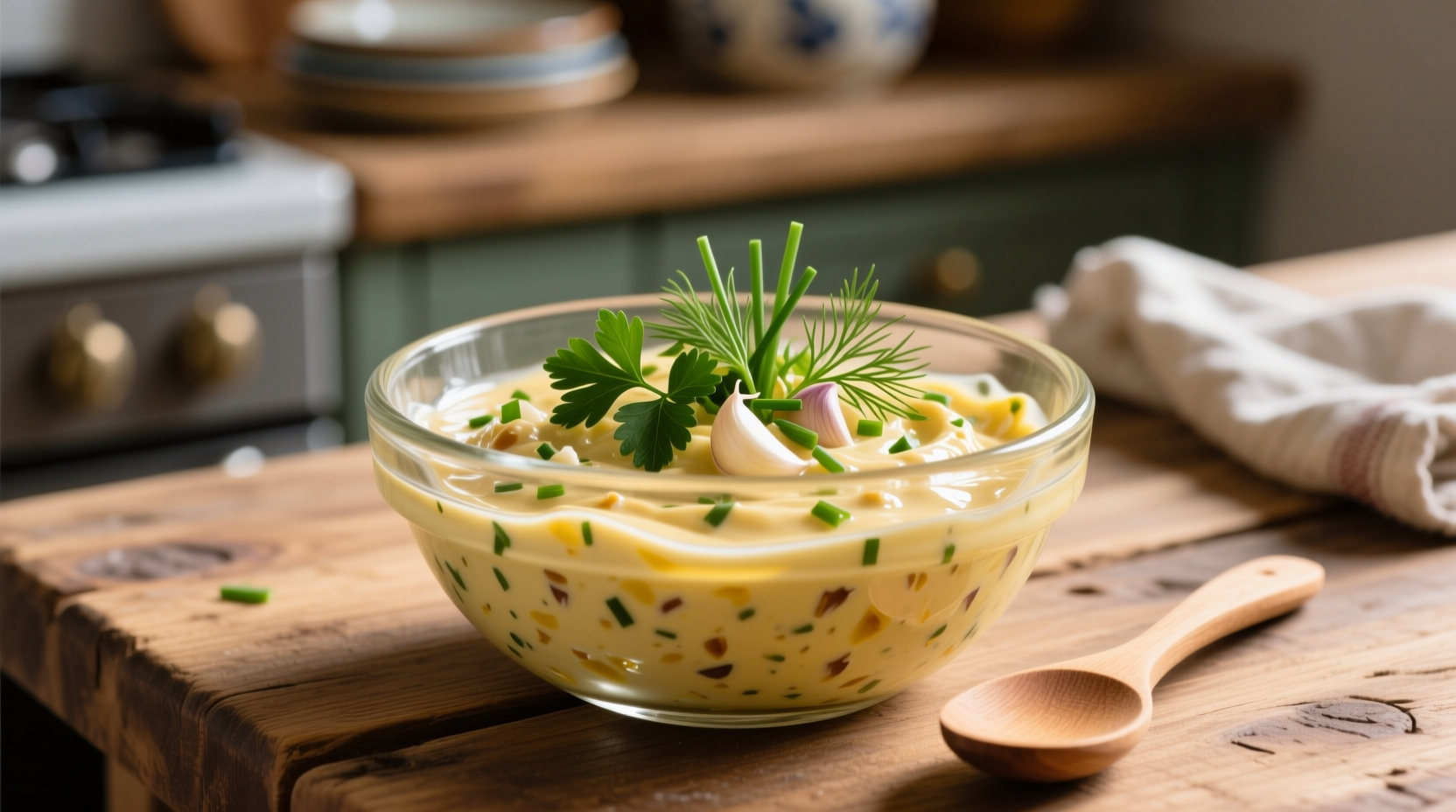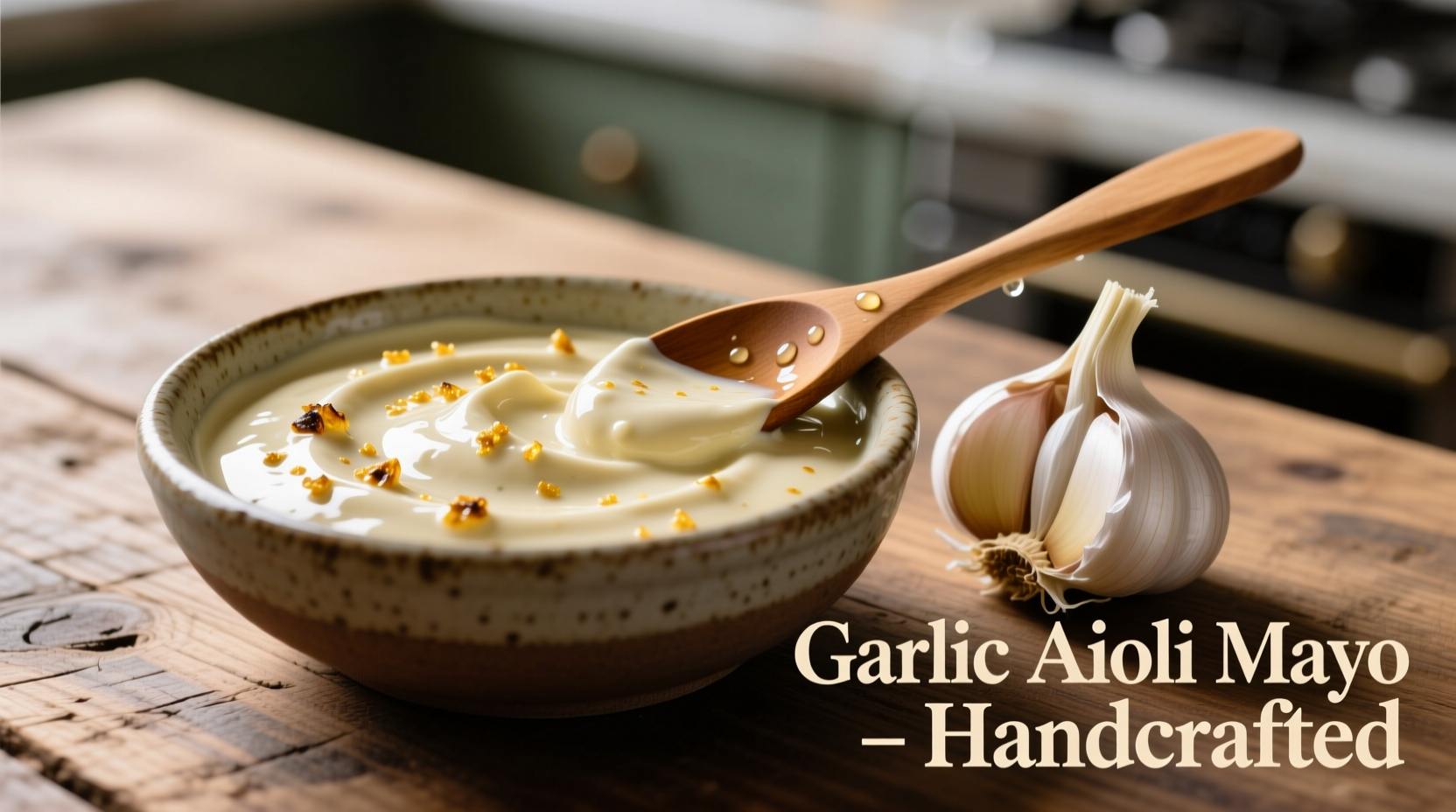As a French-trained chef specializing in European spice traditions, I've spent years perfecting this essential sauce. Garlic aioli mayo bridges the gap between authentic Provençal aioli and modern mayonnaise, creating a user-friendly condiment that maintains culinary integrity while adapting to contemporary kitchens.
Understanding the Sauce Spectrum: Aioli vs Mayo vs Garlic Aioli Mayo
Many home cooks confuse these related but distinct sauces. The key differences lie in their ingredients, preparation methods, and culinary applications. This comparison clarifies the distinctions:
| Characteristic | Traditional Aioli | Standard Mayonnaise | Garlic Aioli Mayo |
|---|---|---|---|
| Primary Base | Olive oil emulsified with garlic | Egg yolks emulsified with neutral oil | Mayo base enhanced with garlic |
| Garlic Content | Essential (3-6 cloves per serving) | None | Significant (2-4 cloves per cup) |
| Texture | Thick, almost paste-like | Smooth, creamy | Creamy with garlic texture |
| Preparation Time | 15-20 minutes (hand-whisked) | 5-7 minutes | 5 minutes (mixing) |
| Shelf Life | 24 hours (no egg) | 2-3 weeks | 1-2 weeks |
Historical Evolution: From Mortar to Modern Kitchen
Aioli's journey spans centuries, evolving from a simple Provençal peasant food to a globally recognized condiment. Understanding this timeline helps appreciate why garlic aioli mayo represents such a practical adaptation:
- Pre-1800s: Traditional aioli prepared exclusively in a mortar and pestle with garlic, olive oil, and salt—no eggs
- Early 1800s: Mayonnaise emerges in French cuisine, creating a more stable emulsion with egg yolks
- Mid-1900s: Commercial mayonnaise becomes widely available, changing home cooking practices
- 1980s-1990s: "Aioli" begins appearing on American menus, often mislabeled as garlic mayonnaise
- Present Day: Garlic aioli mayo represents the practical fusion of authentic technique and modern convenience
This evolution reflects broader culinary trends where traditional techniques adapt to contemporary lifestyles without sacrificing essential flavor profiles.
When Garlic Aioli Mayo Shines (And When to Choose Alternatives)
Understanding context boundaries ensures you use this sauce effectively. While incredibly versatile, garlic aioli mayo has specific applications where it excels and situations where other options work better:
Ideal Applications
- Seafood accompaniment: Perfect with grilled shrimp, fish tacos, and crab cakes (University of California Cooperative Extension confirms garlic complements seafood's natural sweetness)
- Sandwich enhancement: Elevates turkey, roast beef, and vegetable sandwiches without overwhelming
- Vegetable dipping: Excellent with roasted asparagus, artichokes, and grilled zucchini
Situations Requiring Alternatives
- Formal French presentations: Traditional Provençal dishes require authentic hand-made aioli
- Extended outdoor service: Mayo-based sauces risk spoilage in temperatures above 70°F (FDA Food Code guidelines)
- Garlic-sensitive diets: Those with IBS or garlic intolerance need alternatives
Creating Perfect Garlic Aioli Mayo: Professional Technique
While store-bought versions exist, homemade garlic aioli mayo delivers superior flavor and texture. Follow these steps for restaurant-quality results:
- Prepare your garlic: Use 2-3 fresh cloves per cup of mayo. Mince finely or press through a garlic press
- Neutralize harshness: Mix minced garlic with 1/4 teaspoon salt and let sit 10 minutes to mellow raw bite
- Select quality base: Choose a high-fat (70%+ oil content) mayonnaise for best texture
- Combine gradually: Fold garlic into mayo in two additions, allowing flavors to integrate
- Rest for flavor development: Refrigerate 2 hours before serving to allow garlic flavors to bloom
For optimal results, use extra-virgin olive oil-based mayonnaise when possible—this creates better flavor harmony with the garlic. Avoid pre-minced garlic from jars, which contains preservatives that dull the fresh garlic flavor.

Culinary Pairing Guide: Maximizing Flavor Impact
Garlic aioli mayo's versatility shines when paired thoughtfully with complementary foods. These pairings leverage flavor chemistry principles to create balanced taste experiences:
- With proteins: The fat content carries garlic flavor to meat surfaces while the acidity cuts through richness—ideal for burgers, chicken sandwiches, and grilled pork
- With vegetables: Enhances roasted or grilled vegetables by complementing caramelization notes (especially effective with eggplant, zucchini, and bell peppers)
- As a base for dips: Mix with roasted red peppers, lemon zest, or fresh herbs for restaurant-quality dipping sauces
- In potato salad: Provides creaminess with more complex flavor than standard mayo versions
Professional chefs often add a touch of lemon juice or Dijon mustard to their garlic aioli mayo to enhance flavor complexity and stabilize the emulsion.
Storage Guidelines and Food Safety
Proper storage ensures both safety and quality. Follow these evidence-based recommendations from the USDA Food Safety and Inspection Service:
- Store in airtight container in refrigerator below 40°F (4°C)
- Consume within 7-10 days for optimal flavor and safety
- Discard if you notice separation that doesn't reincorporate with stirring
- Never leave at room temperature for more than 2 hours (1 hour if above 90°F/32°C)
The egg content in mayonnaise-based sauces requires careful temperature management. While the acidic environment inhibits bacterial growth, proper refrigeration remains essential for food safety.
Creative Variations to Explore
Once you've mastered the classic version, experiment with these professional variations that maintain the essential garlic aioli mayo character while adding new dimensions:
- Lemon-Herb: Add 1 tablespoon fresh lemon juice and 2 teaspoons chopped tarragon per cup
- Smoked Paprika: Incorporate 1/2 teaspoon smoked paprika for depth without heat
- Truffle-Infused: Mix in 1/4 teaspoon white truffle oil for special occasions
- Roasted Garlic: Substitute raw garlic with 3-4 cloves roasted garlic for sweeter, mellower flavor
These variations demonstrate how understanding the base sauce allows for creative adaptation while maintaining culinary integrity—a principle I emphasize in my European spice blending workshops.











 浙公网安备
33010002000092号
浙公网安备
33010002000092号 浙B2-20120091-4
浙B2-20120091-4